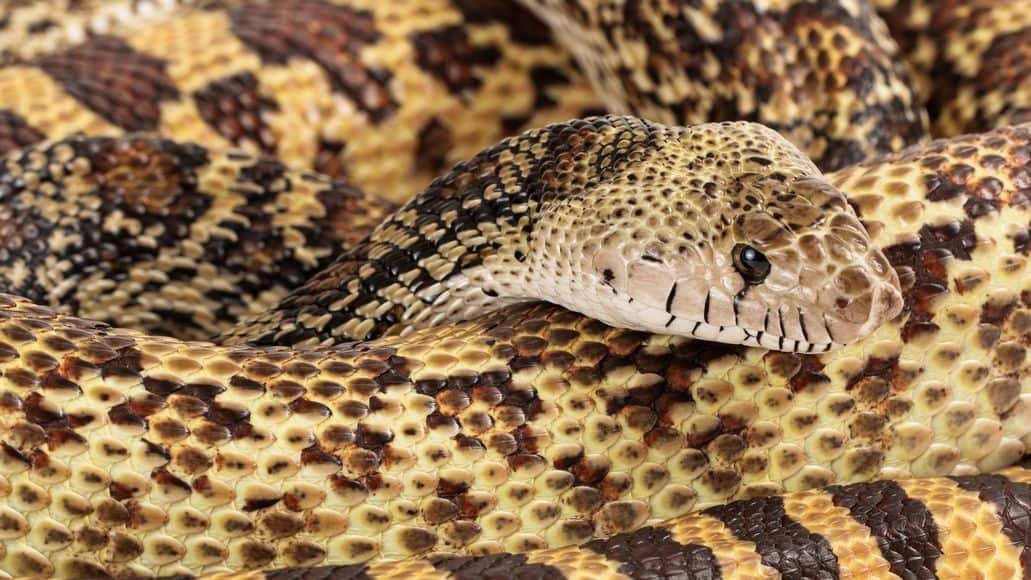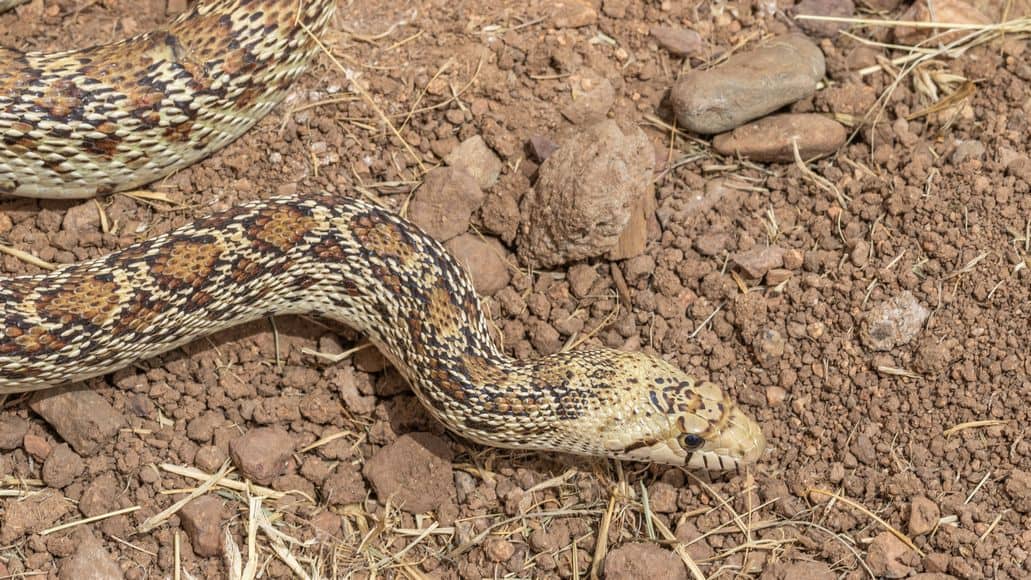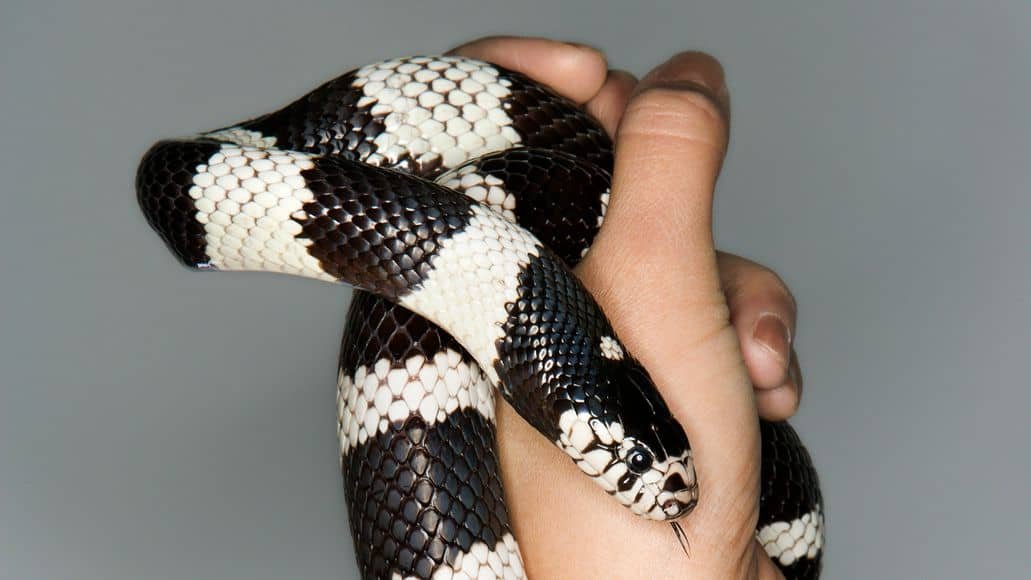
Despite the aggressive sounding name, these snakes are harmless and they make great pets.
But there is one potential issue: their size.
They are one of the largest snakes you’ll find in the US and that size means they need more space and more food than most other species.
Before deciding to care for a bullsnake, make sure you have the ability to provide both of those things: a steady supply of rats and a large enough space to make your snake feel comfortable and happy.
If so, then the bullsnake might be the ideal pet for you. Read on to learn what is takes to care for a bullsnake.
Table of Contents
Bullsnake Care
Before we dive into how best to care for your bullsnake, let’s take a look at some common bullsnake facts you should know.
9 Facts About Bullsnakes

- Bullsnakes are non-venomous snakes and their bite causes no harm to humans or animals. Rest assured that a bull snake poses no danger to you or to any other pets living under your roof.
- Bullsnakes save farmers hundreds of dollars when it comes to rodent control. Some farmers let them live in their barns so they can prey on rodents and keep the populations in check.
- They are constrictors and a type of gopher snake. They kill their prey by coiling around them and squeezing tight. Since their bite is non-venomous, this is the only way they can kill their prey before ingesting it.
- Bullsnakes are sometimes confused with rattlesnakes. Although they are completely different species, they are confused for each other due to their similar scale color and stripes. Bull snakes also mimic rattlesnakes by hissing and vibrating their tails when they are threatened, frightened or cornered.
- The bull snake possesses relatively small teeth, making its bite quite painless and comparable to a nip from a cat.
- They like to bluff when confronted by an enemy. They will bash their head into a perceived threat and then immediately retreat without biting. Some believe that they owe their name to this behavior.
- Others believe they owe their name to the loud snorting sound they make whenever they are threatened, which is similar to the noise from a bull.
- These snakes have a very long lifespan; when bred in captivity, they can live for more than 20 years.
- Bullsnakes are slow moving snakes and they are good climbers
Bullsnake Size And Appearance
As mentioned, the bullsnake is one of the largest species of snakes found in the United States. They are very muscular and their large size makes them very intimidating to both humans and other snakes.

Hatchlings and young snakes range from 7.9 to 18 inches (20 to 46 cm), with an average length of 13 inches (33 cm), while adults range from 48 to 68 inches (122 to 173 cm) in length.
If you think this might be too large a snake for you, read fox snake vs bull snake for a comparison with a smaller breed that might make a better pet for you. Gopher snake vs bull snake might also help. It compares the bull snake to other (smaller) types of gopher snakes.
These snakes have a yellow colored base with brown stripes around their back. When compared with other snakes of the same size, bullsnakes have distinct heads with larger eyes and slim necks.
The hatchlings are very susceptible to predator attack. Predators like skunks, eagles, hawks, and raptors feed on young bull snakes.
But when they grow up, they become the predators. They feed on small animals like rats, rabbits, mice, squirrels, and frogs. It is also not uncommon for bull snakes to feed on rattlesnakes, since their size gives them a large advantage against other snakes.
The average weight of a bullsnake ranges from 2.2 to 3.3 pounds (1 to 1.5 kg), although there are larger specimens with an average weight of 7.7 to 9.9 pounds (3.5 – 4.5 kg). Their size is often determined by how regularly they feed and how much they can consume in each feeding.
One key bullsnake fact to note is that they are diurnal: they are very active during the day. They hunt early in the morning and sometimes late in the afternoon, when the temperature is warm and not hot. Knowing this will give you an idea on the right time to feed your pet.
These snakes do not possess fangs, but they have small teeth which they use to defend themselves. Although the bullsnake bite is harmless and most times painless, it can cause minor bleeding.
Caring For Your Bullsnake

You now know the most important bullsnake facts and you have an idea of their general appearance and size. Let’s move on to the care of bullsnakes, how to keep them as pets and their specific and unique requirements.
Feeding
Unlike wild bullsnakes, those bed in captivity have an especially have a strong appetite. You should not have any problem getting your snake to eat.
What do bull snakes eat? In the wild, they consume anything they can catch, kill and swallow whole.
In captivity, we recommend thawed mice or rats, because they are easy to feed to the snakes and are also very safe for your them.
Feed young snakes every 4 to 8 days and adults every 10 to 15 days. If you notice your snake getting fat, reduce the frequency of feeding.
Water
Bullsnakes are water lovers. They must have fresh water available at all times. Clean the water bowl regularly, either with bleach or antibacterial soaps. Change the water immediately, if you notice feces or other contaminants in it.
Handling
There are situations that require you holding or lifting your pet snake. In such situations, approach the snake slowly, especially if it is new and not yet used to you completely.
Bull snakes are easily threatened and may try to strike you when you approach them. As mentioned earlier, their bite is harmless, but it may cause bleeding. To avoid being bitten, handle these snakes carefully, without spooking them.
Housing
You already know how big the bull snake can get, so you know the enclosure should be larger than for most beginner snakes. A small cage is okay for young snakes, while a medium-sized cage would be suitable for adults.
A good size is 4 feet long by 1.5 to 2 feet wide. Bigger is better, of course. This buyer’s guide for snake enclosures will help you find the right one. Keep the terrarium clean and once a month, do a complete clean.
Temperature

Snakes do not have the ability to regulate their body temperature internally. They need an external source of heat, which you must provide.
Keep temperatures in the enclosure between 73 and 86° F (23 and 30° C) during the daytime. When night falls, you can reduce the temperature by a few degrees. You can supply heat to your snakes through heating pads or heating bulbs. The pads supply heat from below while the bulbs supply heat from above.
Light
Since your snake will be spending most of its time indoors, you need to provide some sort of lighting to replace the natural light from the sun. Equip this light with a timer to automatically turn off and on. Fluorescent lights are ideal.
You could also place the snake enclosure close to a window so that your snake can get adequate sunlight.
Bullsnake Care Is Not So Difficult
Quite easy, right? The simple truth is – taking care of bullsnakes is not difficult at all.
As long as you provide them with their basic needs, you should not have any problems. Make sure they have the proper food, housing and temperature.
Finally, if your snake does bite you, try not to panic, as you might injure the snake. Remember that the bullsnake bite does not inject venom into your body.
If you get bitten by your bullsnake, gently lift the head from your skin and place the snake carefully back in its cage. Then clean your would thoroughly with soap and water. Keep an eye on it for signs of infection. If it looks infected, see a doctor.
What You Need To Know About Pet Snakes

If you are considering getting a pet snake, whether it is a bullsnake or any other species, there are some things you need to know. Snakes are definitely not the best pets for everyone, because they do require special attention and care
That said, they require less hands-on care than most other pets. Here is a list of things you must know and consider before you decide on getting a snake.
- I’m sure you already know that snakes are carnivorous. That means you should not expect to find their food in cans, like dog or cat food. You need to be prepared to feed your snakes with their natural prey. This means either live, pre-killed, or frozen rats and mice.
- You should also know that snakes have very long life-span. If you decide to get one, be ready to care for it for the next 15 to 20 years, or even longer, depending on the species.
- You also need to take into account where you will keep your snake. You need a hbitat with the proper environmental conditions. It also needs to be escape-proof. Make sure there are no holes or gaps that snakes can creep through, because they are notorious escape artists.
- Don’t get a venomous snake, especially if this is your first pet snake. There is a many species of non-venomous snakes that make excellent pets and pose no harm to you. Some non-venomous snakes recommended for beginners are: corn snakes, bullsnakes, rosy boas, milk snakes, and ball pythons.
Bullsnakes: Final Thoughts
The Bullsnake is loved by owners and breeders. It is one of the easiest snakes to keep and one of the most common species in North America. The one drawback over other snakes that are good for beginners is the size. Bullsnakes get much larger than smaller snakes that are good as pets.
This means you will need more space to house your snake. You will also need to spend more money on food, though snakes in general do not eat nearly as much as most pets. If you have the space and can afford to keep one, then a bullsnake makes a wonderful pet.
Tom Klimek says
I recently purchased a young bull snake. The breeder said it was feeding on live fuzzies. I tried feeding her a frozen thawed and she is not interested. Any ideas on switching over?
Gordon Wilson says
Have you tried moving it around in front of her, to make her think it’s alive?